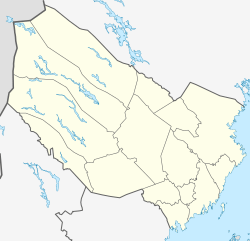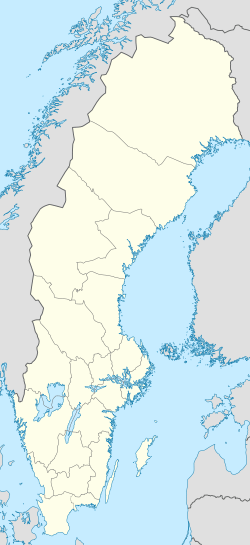Lycksele facts for kids
Quick facts for kids
Lycksele
|
|
|---|---|

Late 1970s in Lycksele
|
|
| Country | Sweden |
| Province | Lapland |
| County | Västerbotten County |
| Municipality | Lycksele Municipality |
| Area | |
| • Total | 8.53 km2 (3.29 sq mi) |
| Population
(31 December 2010)
|
|
| • Total | 8,513 |
| • Density | 998/km2 (2,580/sq mi) |
| Time zone | UTC+1 (CET) |
| • Summer (DST) | UTC+2 (CEST) |
Lycksele is a town in Sweden. It is located in Västerbotten County, which is part of the Lapland province. Lycksele is the main town, or "seat," of Lycksele Municipality. In 2010, about 8,513 people lived there.
Contents
Lycksele's Early History
Before the 1600s, there were no permanent towns in southern Lapland. The area was mostly used by the forest Sami people for grazing their reindeer. They did not live in one place all year round.
The Swedish government wanted to have more control over the area. They needed places where people could meet regularly. So, churches and marketplaces were set up. These places allowed Sami people, traders, and new settlers to come together. It was also where taxes were collected.
The First Settlement at Öhn
One of these important meeting places was on a peninsula in the Ume River. This spot is now called Gammplatsen. It used to be a major winter home for the Sami people.
In 1607, King Charles IX chose Öhn to be a church and market center for southern Lapland. This is how Lycksele began. The town celebrated its 400th birthday in 2007.
Moving and Growing the Town
As Lycksele grew, the small peninsula became too crowded. In 1785, the local church group decided to build a new church. They also moved the marketplace to a new spot called Heden, a little further downstream.
Lycksele continued to develop. In 1926, it became a "köping," which is a type of small town with its own local government. This happened two years after a railway line was built to the town. The railway helped Lycksele connect with other places.
In 1946, Lycksele was given "city rights." This made it the very first city in Lapland! People sometimes call it "Lappstockholm." This name shows its importance as Lapland's first city and a key meeting point.
Modern Lycksele and Population Changes
After the railway arrived, Lycksele grew into a typical small town. It developed small industries and important public services. These included a hospital, a high school, and a local court. The first Swedish Sami school, called Skytteanska skolan, was built here in 1634.
The town's population was highest in the 1970s. After that, the number of people living there started to go down. Recently, this trend has slowed a bit. This is partly because the mining industry in the area is growing. However, Lycksele still faces the challenge of people moving away. In 2000, Lycksele had 8,692 residents. By 2005, this number had slightly decreased to 8,597.
Sports in Lycksele
Lycksele has several sports clubs where people can play different games. Here are some of them:
- Betsele IF
- Lycksele IF
- Lycksele SK
- Öråns SK
Famous People from Lycksele
Many notable people have come from Lycksele. Here are a few:
- Eva Björklund, a politician
- Elisabeth Svantesson, who is a Minister for Finance
- Levi Borgstrom, a carver
- Melker Karlsson, an ice hockey player
- John Lindgren, a cross-country skier
- Figge Norling, an actor
- David Rundblad, an ice hockey player who won the Stanley Cup
- Maic Sema, a football player
- Linn Svahn, a cross-country skier
- Andreas Wingerli, an ice hockey player
Lycksele's Climate
Lycksele has a subarctic climate. This means it has short, mild summers and long, cold, snowy winters. Even though Lycksele is very far north, its climate is not as extreme as some other places at the same latitude. This is because of the Gulf Stream. The Gulf Stream is a warm ocean current that helps to keep the weather milder.
| Climate data for Lycksele (2002–2020 averages; extremes since 1945) | |||||||||||||
|---|---|---|---|---|---|---|---|---|---|---|---|---|---|
| Month | Jan | Feb | Mar | Apr | May | Jun | Jul | Aug | Sep | Oct | Nov | Dec | Year |
| Record high °C (°F) | 9.5 (49.1) |
9.9 (49.8) |
14.7 (58.5) |
20.4 (68.7) |
29.0 (84.2) |
31.9 (89.4) |
33.2 (91.8) |
30.9 (87.6) |
26.2 (79.2) |
21.6 (70.9) |
13.0 (55.4) |
9.2 (48.6) |
33.2 (91.8) |
| Mean maximum °C (°F) | 3.9 (39.0) |
5.1 (41.2) |
8.9 (48.0) |
15.2 (59.4) |
23.9 (75.0) |
26.8 (80.2) |
28.4 (83.1) |
26.4 (79.5) |
20.5 (68.9) |
13.1 (55.6) |
7.2 (45.0) |
4.9 (40.8) |
29.5 (85.1) |
| Mean daily maximum °C (°F) | −5.7 (21.7) |
−4.0 (24.8) |
1.2 (34.2) |
7.2 (45.0) |
14.0 (57.2) |
18.8 (65.8) |
21.6 (70.9) |
19.4 (66.9) |
13.7 (56.7) |
5.7 (42.3) |
−0.4 (31.3) |
−3.1 (26.4) |
7.4 (45.3) |
| Daily mean °C (°F) | −10.7 (12.7) |
−9.5 (14.9) |
−4.6 (23.7) |
1.7 (35.1) |
7.6 (45.7) |
12.6 (54.7) |
15.5 (59.9) |
14.6 (58.3) |
8.7 (47.7) |
1.9 (35.4) |
−3.9 (25.0) |
−7.6 (18.3) |
2.2 (35.9) |
| Mean daily minimum °C (°F) | −15.7 (3.7) |
−15.0 (5.0) |
−10.4 (13.3) |
−3.9 (25.0) |
1.1 (34.0) |
6.4 (43.5) |
9.4 (48.9) |
7.7 (45.9) |
3.6 (38.5) |
−1.9 (28.6) |
−7.4 (18.7) |
−12.0 (10.4) |
−3.2 (26.3) |
| Mean minimum °C (°F) | −31.5 (−24.7) |
−30.7 (−23.3) |
−25.7 (−14.3) |
−13.3 (8.1) |
−5.7 (21.7) |
−1.0 (30.2) |
1.9 (35.4) |
−0.2 (31.6) |
−3.8 (25.2) |
−13.2 (8.2) |
−20.1 (−4.2) |
−26.7 (−16.1) |
−34.5 (−30.1) |
| Record low °C (°F) | −43.0 (−45.4) |
−41.0 (−41.8) |
−37.2 (−35.0) |
−25.6 (−14.1) |
−12.3 (9.9) |
−4.2 (24.4) |
−1.1 (30.0) |
−4.6 (23.7) |
−8.9 (16.0) |
−25.0 (−13.0) |
−33.2 (−27.8) |
−39.1 (−38.4) |
−43.0 (−45.4) |
| Average precipitation mm (inches) | 29.3 (1.15) |
21.8 (0.86) |
19.4 (0.76) |
23.3 (0.92) |
39.1 (1.54) |
53.3 (2.10) |
76.6 (3.02) |
71.2 (2.80) |
53.6 (2.11) |
43.5 (1.71) |
32.7 (1.29) |
38.9 (1.53) |
502.7 (19.79) |
| Source 1: SMHI Open Data | |||||||||||||
| Source 2: SMHI climate data 2002–2020 | |||||||||||||
See also
 In Spanish: Lycksele para niños
In Spanish: Lycksele para niños



